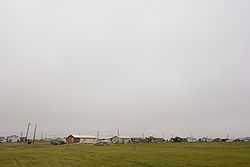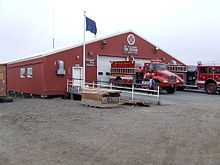Nuiqsut, Alaska
| Nuiqsut | |
|---|---|
| City | |
 | |
 Nuiqsut | |
| Coordinates: 70°12′59″N 151°00′21″W / 70.21639°N 151.00583°WCoordinates: 70°12′59″N 151°00′21″W / 70.21639°N 151.00583°W | |
| Country | United States |
| State | Alaska |
| Borough | North Slope |
| Incorporated | June 24, 1975[1] |
| Government | |
| • Mayor | Dwayne Hopson, Sr.[2] |
| Area | |
| • Total | 9.2 sq mi (23.9 km2) |
| • Land | 9.2 sq mi (23.9 km2) |
| • Water | 0.0 sq mi (0.0 km2) |
| Elevation | 23 ft (7 m) |
| Population (2010)[3] | |
| • Total | 402 |
| • Density | 44/sq mi (17/km2) |
| Time zone | Alaska (AKST) (UTC-9) |
| • Summer (DST) | AKDT (UTC-8) |
| ZIP code | 99789 |
| Area code | 907 |
| FIPS code | 02-56320 |
| GNIS feature ID | 1416680, 2419439 |
Nuiqsut (Noak-sit)[4] is a city[3][5] in North Slope Borough, Alaska, United States. The population was 433 at the 2000 census[6] and 402 as of the 2010 census.[3]
Geography
Nuiqsut is located at 70°12′59″N 151°0′21″W / 70.21639°N 151.00583°W (70.216338, -151.005725).[7]
Nuiqsut is in the North Slope Borough on the Nechelik Channel, about 35 miles (56 km) from the Beaufort Sea coast. According to the United States Census Bureau, the city has a total area of 9.2 square miles (24 km2), all of it land. Air travel to the Nuiqsut Airport provides the only year-round access to Nuiqsut. Nuiqsut is accessible during the winter via an ice road and was featured in season four episode of the History television channel series Ice Road Truckers, when a convoy of truckers delivered supplies to the village.
Demographics
As of the census[6] of 2000, there were 433 people, 110 households, and 90 families residing in the city. The population density was 47.0 people per square mile (18.2/km²). There were 126 housing units at an average density of 13.7 per square mile (5.3/km²). The racial makeup of the city was 10.16% White, 0.23% Black or African American, 88.22% Native American, 0.46% Asian, and 0.92% from two or more races. 0.23% of the population were Hispanics or Latinos of any race.
There were 110 households out of which 54.5% had children under the age of 18 living with them, 42.7% were married couples living together, 22.7% had a female householder with no husband present, and 17.3% were non-families. 15.5% of all households were made up of individuals and 0.9% had someone living alone who was 65 years of age or older. The average household size was 3.93 and the average family size was 4.24.
The age distribution was 42.0% under 18, 9.5% from 18 to 24, 30.5% from 25 to 44, 13.6% from 45 to 64, and 4.4% who were 65 or older. The median age was 24 years. For every 100 females there were 147.4 males. For every 100 females age 18 and over, there were 130.3 males.
The median income for a household in the city was $48,036, and the median income for a family was $46,875. Males had a median income of $31,667 versus $25,625 for females. The per capita income for the city was $14,876. About 3.2% of families and 2.4% of the population were below the poverty line, including 1.1% of those under age 18 and none of those age 65 or over.
Business, commerce and social centers

Education
There is one school in Nuiqsut for grades kindergarten through 12th grade. The school also provides preschool. There are approximately 100 students. There are approximately 9 teachers and 6 other staff members. Many community functions are held in the school and it serves as social center as well as school. The school facilities also serve as an emergency shelter for the community in times of power outages.
Culture and history
The native people of the village are Inupiat. The village was re-established in the early 1970s when the residents moved to the region from Barrow. For one year they lived in tents while housing was built. These original residents were the first to receive dividends from the oil companies in exchange for land use. The dividends are passed from the original shareholders on to the community member of their choice (often parent to child).
Native traditions such as hunting (whale, caribou, fox, ptarmigan, etc.) and the making of native clothes and crafts continues, although the influence of modern society has reduced both need and interest in these activities to some degree. The traditional whale hunted by the whalers of Nuiqsut is the bowhead whale.
Natural resources
Nuiqsut is located in the midst of a vast quantity of oil. Many major oil companies have oil facilities in the region (ConocoPhillips, BP, etc.). The relationship with the community of Nuiqsut is such that the oil company using the land, considered to be the property of the native Nuiqsut residents (Inupiat Eskimos), pay dividends to residents in exchange for use of the land. For many native residents the dividends are the primary, or only, source of income.
References
- ↑ 1996 Alaska Municipal Officials Directory. Juneau: Alaska Municipal League/Alaska Department of Community and Regional Affairs. January 1996. p. 110.
- ↑ "Community: Nuiqsut". Community Database Online. Juneau: Alaska Department of Commerce, Community and Economic Development, Division of Community and Regional Affairs. 2013. Retrieved June 4, 2013.
- ↑ 3.0 3.1 3.2 "Nuiqsut city, Alaska". Profile of General Population and Housing Characteristics: 2010 Demographic Profile Data. United States Census Bureau. Retrieved January 23, 2013.
- ↑ "Nuiqsut". Division of Community and Regional Affairs, Alaska Department of Commerce, Community and Economic Development. Retrieved January 23, 2013.
- ↑ "Alaska Taxable 2011: Municipal Taxation - Rates and Policies" (PDF). Division of Community and Regional Affairs, Alaska Department of Commerce, Community and Economic Development. January 2012.
- ↑ 6.0 6.1 "American FactFinder". United States Census Bureau. Retrieved 2008-01-31.
- ↑ "US Gazetteer files: 2010, 2000, and 1990". United States Census Bureau. 2011-02-12. Retrieved 2011-04-23.
| ||||||||||||||||||||
